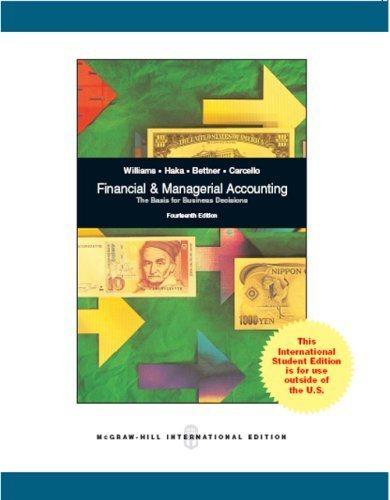Question
Presented below is the comparative balance sheet forIvanhoeInc., a private company reporting under ASPE, at December 31, 2021, and 2020: IVANHOEINC. Balance Sheet December 31Assets
Presented below is the comparative balance sheet forIvanhoeInc., a private company reporting under ASPE, at December 31, 2021, and 2020:
IVANHOEINC.
Balance Sheet
December 31Assets20212020Cash$67,000$98,000Accounts receivable101,00075,000
Inventory205,000155,500
Long-term investment101,500
0Property, plant, and equipment
535,000
460,000
Less: Accumulated depreciation(162,500)(140,000
)$847,000
$648,500
Liabilities and Shareholders' EquityAccounts payable$57,500
$47,000
Dividends payable6,0000Income tax payable14,00015,000
Long-term notes payable25,000
0Common shares630,000
525,000
Retained earnings114,500
61,500
$847,000
$648,500
IVANHOEINC.
Income Statement
Year Ended December 31, 2021
Sales$663,000
Cost of goods sold432,000
Gross profit231,000
Operating expenses
$147,500
Loss on sale of equipment3,000
150,500
Profit from operations80,500
Interest expense3,000
Interest revenue(4,500
)(1,500)Profit before income tax82,000
Income tax expense14,000Profit$68,000
Additional information:1.
Cash dividends of $15,000were declared.
2.
A long-term investment was acquired for cash at a cost of $101,500.
3.
Depreciation expense is included in the operating expenses.
4.
The company issued10,500common shares for cash on March 2, 2021. The fair value of the shares was $10per share. The proceeds were used to purchase additional equipment.
5.
Equipment that originally cost $30,000was sold during the year for cash. The equipment had a carrying value of $9,000at the time of sale.
6.
The company issued a note payable for $28,000and repaid $3,000by year end.
7.All purchases of inventory are on credit.8.Accounts Payable is used only to record purchases of inventory.
Prepare a cash flow statement for the year using the indirect method.(Show amounts that decrease cash flow with either a - sign e.g. -15,000 or in parenthesis e.g. (15,000).)
IVANHOEINC.
Cash Flow Statement - Indirect Method
Year Ended December 31, 2021
Month Ended December 31, 2021
December 31, 2021
Cash, December 31
Net Cash Used by Investing Activities
Net Cash Provided by Financing Activities
Cash, January 1
Financing Activities
Investing Activities
Operating Activities
Net Cash Provided by Operating Activities
Net Cash Used by Operating Activities
Net Cash Used by Financing Activities
Net Increase in Cash
Net Decrease in Cash
Net Cash Provided by Investing Activities
Increase in Accounts Receivable
Purchase of Equipment
Payment of Dividends
Depreciation Expense
Sale of Equipment
Payments for Operating Expenses
Collections from Customers
Increase in Inventory
Repayment of Note Payable
Issue of Note Payable
Increase in Accounts Payable
Loss on Sale of Equipment
Issuance of Common Shares
Profit
Payments to Suppliers
Acquisition of Long-Term Investment
Decrease in Income Tax Payable
Payments for Taxes
$Adjustments to reconcile profit to
Net Cash Used by Investing Activities
Net Cash Used by Financing Activities
Cash, December 31
Net Cash Provided by Financing Activities
Net Decrease in Cash
Net Increase in Cash
Net Cash Used by Operating Activities
Financing Activities
Cash, January 1
Net Cash Provided by Investing Activities
Net Cash Provided by Operating Activities
Operating Activities
Investing Activities
Issuance of Common Shares
Profit
Loss on Sale of Equipment
Increase in Accounts Payable
Payments to Suppliers
Collections from Customers
Payment of Dividends
Repayment of Note Payable
Issue of Note Payable
Purchase of Equipment
Payments for Taxes
Decrease in Income Tax Payable
Sale of Equipment
Depreciation Expense
Increase in Inventory
Payments for Operating Expenses
Acquisition of Long-Term Investment
Increase in Accounts Receivable
$
Payments to Suppliers
Issuance of Common Shares
Purchase of Equipment
Increase in Inventory
Collections from Customers
Payments for Operating Expenses
Payment of Dividends
Payments for Taxes
Increase in Accounts Payable
Profit
Depreciation Expense
Increase in Accounts Receivable
Repayment of Note Payable
Loss on Sale of Equipment
Decrease in Income Tax Payable
Issue of Note Payable
Sale of Equipment
Acquisition of Long-Term Investment
Issue of Note Payable
Purchase of Equipment
Increase in Inventory
Payment of Dividends
Decrease in Income Tax Payable
Profit
Payments for Taxes
Repayment of Note Payable
Increase in Accounts Payable
Payments for Operating Expenses
Increase in Accounts Receivable
Issuance of Common Shares
Depreciation Expense
Collections from Customers
Loss on Sale of Equipment
Sale of Equipment
Acquisition of Long-Term Investment
Payments to Suppliers
Decrease in Income Tax Payable
Payments for Taxes
Repayment of Note Payable
Issue of Note Payable
Purchase of Equipment
Increase in Accounts Payable
Issuance of Common Shares
Payments to Suppliers
Payment of Dividends
Increase in Inventory
Depreciation Expense
Loss on Sale of Equipment
Sale of Equipment
Profit
Increase in Accounts Receivable
Collections from Customers
Payments for Operating Expenses
Acquisition of Long-Term Investment
Sale of Equipment
Payment of Dividends
Issuance of Common Shares
Purchase of Equipment
Payments to Suppliers
Acquisition of Long-Term Investment
Repayment of Note Payable
Depreciation Expense
Increase in Accounts Payable
Payments for Taxes
Collections from Customers
Decrease in Income Tax Payable
Increase in Accounts Receivable
Issue of Note Payable
Loss on Sale of Equipment
Payments for Operating Expenses
Increase in Inventory
Profit
Increase in Inventory
Issue of Note Payable
Purchase of Equipment
Loss on Sale of Equipment
Repayment of Note Payable
Collections from Customers
Increase in Accounts Payable
Decrease in Income Tax Payable
Payments for Operating Expenses
Issuance of Common Shares
Acquisition of Long-Term Investment
Payments to Suppliers
Depreciation Expense
Payments for Taxes
Payment of Dividends
Sale of Equipment
Increase in Accounts Receivable
Profit
Step by Step Solution
There are 3 Steps involved in it
Step: 1

Get Instant Access to Expert-Tailored Solutions
See step-by-step solutions with expert insights and AI powered tools for academic success
Step: 2

Step: 3

Ace Your Homework with AI
Get the answers you need in no time with our AI-driven, step-by-step assistance
Get Started


